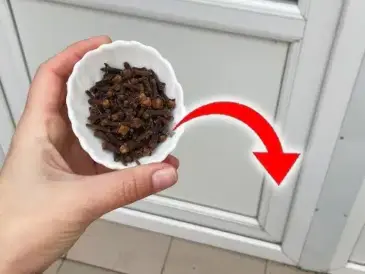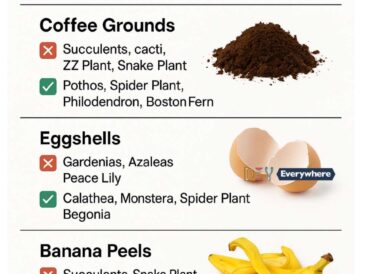As winter sets in, the challenges of keeping houseplants alive and thriving can become more pronounced. The lack of sunlight, dry indoor air, and colder temperatures can stress plants, leading to wilting leaves, slower growth, and in some cases, plant death. However, with a bit of creativity and unconventional methods, you can revive your houseplants and help them flourish even in the harshest winter conditions.
In this article, we explore ten unconventional yet effective ways to save your dying houseplants during the winter months. From using banana peels to improve leaf shine to setting up humidity tents, these quirky techniques can make a significant difference in your plant’s health. Get ready to discover some unusual but practical tips that can breathe new life into your indoor garden.
1. Use Banana Peels as a Natural Leaf Polish
Banana peels are not just a tasty snack for you; they can also be a natural polish for your plant’s leaves. The inside of a banana peel contains potassium and other nutrients that can help improve leaf health. Simply take a ripe banana peel and gently rub the insides on the leaves of your plants. This will not only clean the leaves by removing dust and grime but also provide them with a nutrient boost. Doing this every few weeks can improve leaf shine and overall plant appearance.
2. Give Your Plants a Shower
Sometimes a good shower can do wonders for your houseplants, especially if they are covered in dust. Place your plants in the shower and use lukewarm water to rinse off the leaves gently. Make sure the water is not too hot or cold, as extreme temperatures can shock the plant. This method helps to remove dust, pests, and other debris that can hinder photosynthesis. Allow the plants to drain thoroughly before placing them back in their usual spot.
3. Try Bottom Watering in the Sink
Bottom watering is an effective way to ensure your plants get the moisture they need without overwatering. Place your potted plants in a sink or basin filled with a few inches of water. Let them sit for about 15-30 minutes, allowing the soil to soak up water from the drainage holes. This method encourages roots to grow downward and prevents water from sitting on the surface, reducing the risk of mold and fungus.
4. Use Ice Cubes for Controlled Watering
Using ice cubes to water your plants is a clever way to provide consistent moisture without overwatering. Place a few ice cubes on the soil surface around the plant. As the ice melts, it slowly releases water into the soil, giving the plant time to absorb it without overwhelming the roots. This method is particularly useful for orchids and other moisture-sensitive plants. Adjust the number of ice cubes based on the size of the plant and its water needs.
5. Create a Humidity Tent with a Plastic Bag
Dry indoor air in winter can be damaging to plants that thrive in humid environments. To combat this, create a makeshift humidity tent using a clear plastic bag. Cover the plant with the bag, ensuring it does not touch the leaves. Use sticks or stakes to create a frame if necessary. This setup helps retain moisture around the plant. Make sure to remove the bag for a few hours daily to prevent mold and allow for air circulation.
6. Rotate Your Plants for Even Sunlight Exposure
During winter, the angle and intensity of sunlight can change, causing uneven growth in houseplants. To ensure all sides of the plant receive adequate light, rotate your plants a quarter turn every week. This simple practice can encourage balanced growth and prevent the plant from leaning towards the light source. It also provides an opportunity to inspect the plant for any signs of disease or pests.
7. Use Coffee Grounds as a Fertilizer Boost
Coffee grounds can be an excellent source of nitrogen and other nutrients for your houseplants. After brewing your morning coffee, let the grounds cool, and then sprinkle them lightly on the soil surface. Be careful not to overdo it, as too much can alter the soil pH and harm the plant. Use this method once a month to give your plants a gentle nutrient boost. Avoid using coffee grounds for plants that prefer acidic conditions, like succulents or cacti.
8. Revive with a Diluted Green Tea Solution
Green tea is not only refreshing for humans but can also benefit plants. Brew a weak solution of green tea by steeping a tea bag in a liter of water for a few minutes. Allow it to cool, then use it to water your plants once every few weeks. The antioxidants and nutrients in green tea can help revive stressed plants and improve their health. Ensure the solution is not too strong to avoid damaging the plant.
9. Employ a Toothpick for Aerating Soil
Compacted soil can hinder root growth and reduce water absorption. A simple solution is to use a toothpick to gently aerate the soil. Insert the toothpick into the soil around the plant, creating small holes that allow air and water to penetrate more easily. This technique can improve root health and promote better growth. Be careful not to disturb the roots while aerating.
10. Utilize a Humidifier to Improve Air Quality
A humidifier can make a significant difference in the health of your houseplants during winter. By adding moisture to the air, a humidifier helps maintain a suitable environment for plants that require higher humidity levels. Place the humidifier near your plants, but not too close to avoid excess moisture on the leaves. Running the humidifier for a few hours daily can prevent leaf browning and curling, keeping your plants healthy and vibrant.
11. Move Plants Closer to a South-Facing Window
In winter, the sun’s position in the sky changes, and south-facing windows offer the best light exposure. Moving your plants closer to a south-facing window can help them receive more natural light, which is crucial for photosynthesis and growth. Be mindful of drafts and cold air from the window, and consider using sheer curtains to diffuse intense sunlight. Regularly check the temperature and adjust the plant’s position as needed to ensure optimal growing conditions.




